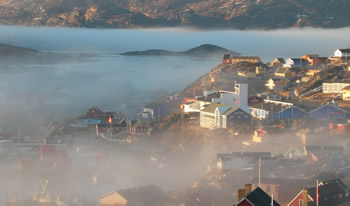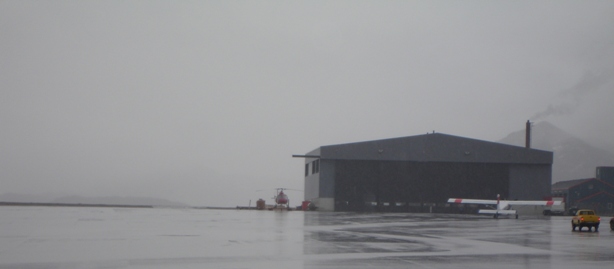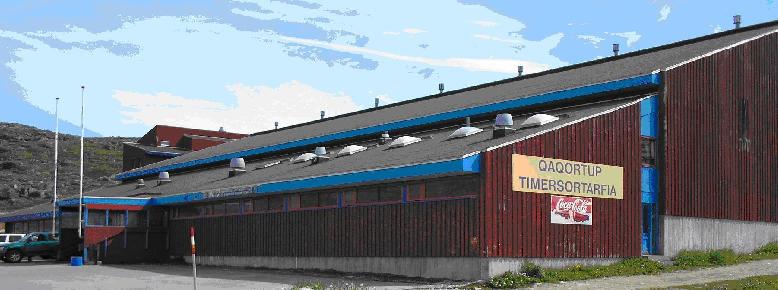The climate in Greenland is arctic. In South Greenland is slightly warmer inland,
and forest growth occurs in all south-facing valleys far from the ocean's
cold summer air.
This means that the climate in South Greenland can be described as subarctic,
but with the same volatility as in normal arctic climate. The air is usually dry,
giving a feeling that the summer temperatures are higher than it actually is.

From May to July it is basically like round the clock
and therefore you can not see the northern lights,
which is looking at the sky from it gets dark at night
in early August to mid-May.
Otherwise, the northern lights can be seen every night
when it is dark and cloudless.
In South Greenland there is a phenomenon called pack ice.
The ice from the Arctic Ocean, who walks down the east coast
of Greenland to South Greenland and can more or less create
problems for navigation in the area in the months from
April to July.
The ice cools the whole area down and makes early summer cold
and damp. It is not possible to predict how much is coming,
let alone how long it will remain. Ocean currents and wind
determines how long the ice will remain in the area. At times,
everything will be closed and impossible to do any kind
of boating, other summers can sail anywhere.
On land, the climate is pleasant, and you can achieve quite
high temperatures on hot summer days. The high temperatures give
very favorable levebetingel-see for mosquitoes, which are present
in impressive numbers. In addition to mosquitoes is another
small insect, called knot or blackflies (similium venustum).
It is therefore advisable that you acquire a mosquito net either
before arrival or when you are in town. Cattle mosquito is
indifferent to virtually any myggeolier.
Once at sea or fjord there are no insects, but the air can
feel very cold. Therefore, you need warm clothes, hat and
mittens with, so you do not incur a cold.
Precipitation may occur in biblical proportions, but also
conspicuous by its absence. Thus, in a few months experience
both desert-like and regnskovslig--like amounts of rainfall.
Like the Danish summer is hard to say periods in which
there are at least precipitation, because it can change from
year to year. Therefore, it is definitely a good idea to
take his raincoat to Greenland.
There are no roads between towns in Greenland, so sailing.
In Europe, virtually every family a car in Greenland has one boat.
This means that there is a great deal of experience in dealing
with the ocean, so it's a good idea to listen to the Greenlanders
and respect the decisions that are made, for they know what they
are talking about. Generally, it is colder on the water than
on land, so they should dress accordingly.
However, the uncertainty is a factor that is a big part of life here.
The word for "when" is the same as "if". You often hear the word "immaqa"
which means possible-show or perhaps, but can also mean "may not" or
"may not". Are we not leaving today, then we do it maybe tomorrow.
It's the weather and nature decides.

The most important for Greenlanders is to have a good time together. Man laughing and
smiling more often, and it's also nicer to enjoy themselves than to be anxious all the time.
Greenlanders are world champions in getting time to go and most of them have a game
of cards in your pocket when traveling.
Do you have to hike in the mountains, there are some basic rules that you should follow:
Be careful with open flames, and always switch off with water, not soil or sand. Limit the
use of live vegetation for fuel - the Greenlandic vegetation grows very slowly.
Thus, one can say that there are roughly 40-50 years before nature comes after excessive use.
We see it clearly in the ice sheet edge, which are about 50 years from the ice moves back
and that is normal stand where the ice once was.
In Greenland, there is an increasing awareness of not polluting nature but still there are
many places where Greenland looks less pure and uncontaminated out than is desirable.
In South Greenland you are good at keeping the cities clean compared to other parts
of the country. But the show a good example and take your litter with you - even if there may
be other debris on the ground. Organic waste should be covered by large rocks or thrown
in rock crevices, as the arctic fox can dig very deep. It is good practice in Greenland
not to throw fiskeind-ramparts and fish heads in trout rivers and lakes.
Good advice before moving on hiking short and long trips:
Tell accommodation where you are going and when you expect to be back.
Listen to the weather forecast!
Listen to good advice from experienced hikers.
Be prepared for bad weather and accidents, even on shorter trips.
Do not go alone.
Turn back before conditions become critical.
Conserve energy and look for shelter while there is still time.
Always bring the necessary first aid equipment.
Always bring extra warm clothing, even on shorter trips.
Take several layers of clothing that can be removed after how hot it is
and have a wool sweater or fleece in your bag.
This was briefly some details that are good to have when you have to
travel to Greenland. You can have 20 kilos when traveling to Greenland,
but please let there be some air to souvenirs. Think always about a second
time when you pack your bag and be sure to weigh it when you're done;
Air Greenland is very strict on excess baggage.
Have a great trip and stay!

NB: The sports hall, located next to Sulisartut Højskoliat offer shower facilities for campers guests in the summer months.